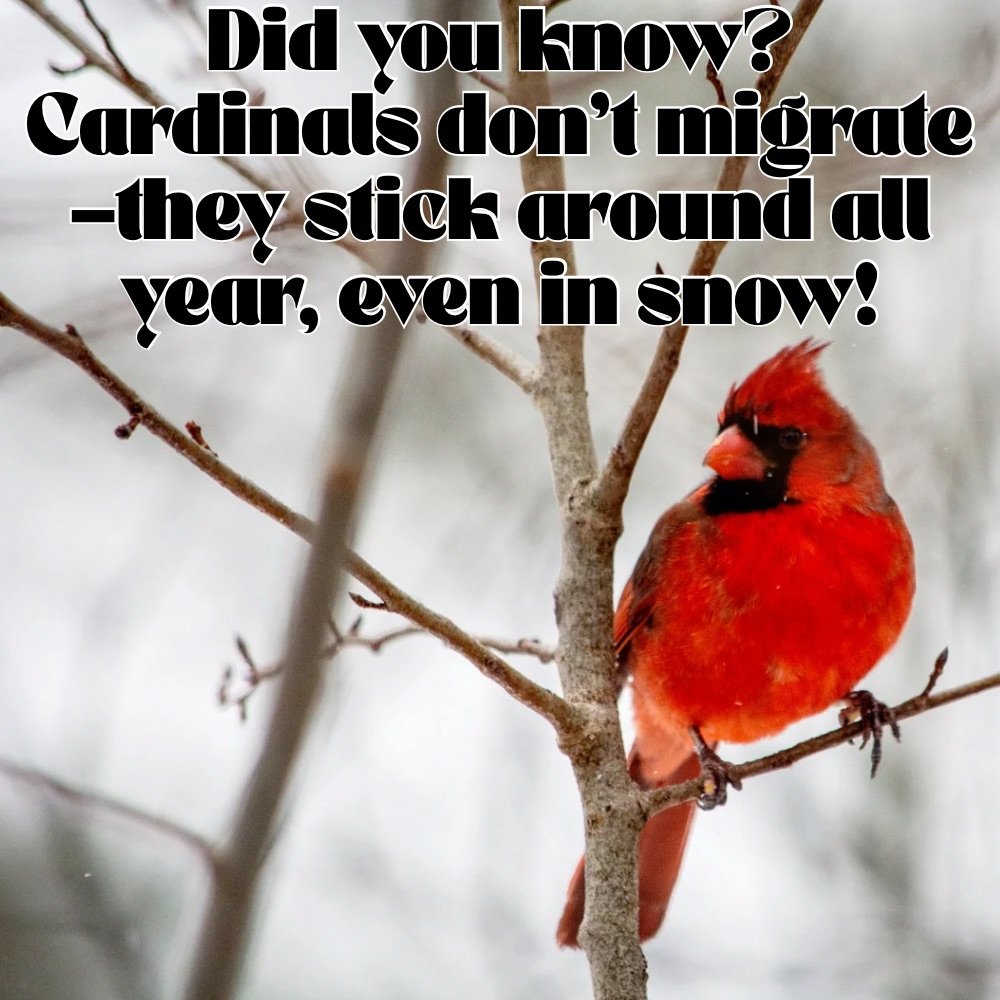
Where Do Cardinals Live in the Wild?
Cardinals are one of the most familiar and loved birds across North America. But if you’re wondering where cardinals live, the answer might surprise you. These bright red beauties (the males, at least) can be found from southern Canada all the way down to parts of Mexico and Central America. They’re mostly known in the eastern and central United States, but their range has been spreading west over the years—thank you, backyard feeders!
They prefer areas that offer dense shrubs and tree cover but avoid deep forests and wide-open plains. You’ll find them in forests’ edge zones, thick backyards, suburban neighborhoods, and even small patches of city green space.
Want a deep dive into their behaviors and lifestyle? Check out our guide 👉 All About Cardinals: Facts, Behaviors, and Backyard Tips
What Kind of Habitats Do Cardinals Prefer?
You won’t catch a cardinal hanging out in a wide-open field. These birds like a mix of cover and open space. Think shrubs, small trees, and patches of brush that give them places to hide and perch. You’re most likely to find them in:
- Overgrown field edges
- Wooded neighborhoods
- Gardens with dense vegetation
- Thickets near creeks or streams
- City parks with natural sections
They’ve learned to adapt to human development quite well, which is why you’ll often spot them in your backyard.
Looking to explore more birds like this? 🐦 Glide on over to our Bird Category and discover who’s flying nearby!

Do Cardinals Migrate?
Nope—cardinals are homebodies. Unlike robins or swallows that take off in winter, cardinals stick around all year. Even in freezing temperatures and snow-covered trees, you’ll still see those red feathers pop against the white backdrop. It’s part of why they’re such a wintertime favorite.
Instead of flying south, they:
- Fluff their feathers to trap heat
- Seek dense evergreen shrubs for shelter
- Change their diet to focus on seeds and grains
So if you’re wondering, where do cardinals go in winter? —they go nowhere. They stay right at home, bundled up and sticking close to reliable food sources.
Where Do Cardinals Nest?
During breeding season, which runs from March to August, cardinals become little architects. Females are the ones who build the nest—usually in dense shrubs or low trees, between 1 and 15 feet off the ground.
They don’t use birdhouses, but they love thick, leafy areas that hide their babies from predators. Some backyard favorites include:
- Honeysuckle
- Dogwood
- Blackberry bushes
- Dense vine tangles
Each nest is a loose bowl of twigs, bark, leaves, and grasses. It’s not pretty—but it gets the job done. Want to know more about how cardinals raise their young? Here’s our full cardinal bird guide loaded with insights.
How Cardinals Claim Their Territory
These little red birds are peaceful-looking… until another male cardinal crosses the line. Males fiercely guard their territory during breeding season. They’ll sing, chase, and even fight to protect their space.
Their territory can span 1–4 acres, depending on food and nesting availability. And interestingly enough, cardinals are known to fight themselves—well, their reflection anyway! They’ll spend hours pecking at mirrors or windows thinking they’ve got a rival nearby.
For more of these fascinating habits, browse our Cardinal Collection—it’s packed with personality!
Cardinals in Backyards and Cities
Cardinals have totally embraced suburban life. You don’t have to go on a wilderness hike to spot one—they’re just as likely to be seen hopping along your fence or perched on your tomato cage.
Why? Because:
- Feeders make food easy
- Shrubs and trees offer perfect nesting cover
- They’re naturally shy and like the privacy of home gardens
If your yard has the right mix of cover, water, and a solid snack selection, chances are, cardinals will move in.
What Regions Are Cardinals Most Common In?
Cardinals are most common east of the Rocky Mountains—especially in:
- Midwest
- Southeast
- Eastern U.S.
- Texas
- Parts of Mexico
They’re slowly making their way west into places like Arizona and California, but they’re still rare out there. You won’t find them in the Pacific Northwest or upper Rockies—too wet, too cold, and too dense with forest.
What Time of Year Are Cardinals Most Active?
You can see them year-round, but spring and early summer are their spotlight seasons. This is when they’re:
- Building nests
- Singing loudly (especially the males)
- Raising young
- Defending territory
Winter is the best time to spot them though—nothing beats the look of a bright red cardinal sitting on a snowy branch.
Where Do Cardinals Sleep at Night?
At night, cardinals aren’t nesting—they’re finding cozy, hidden spots to sleep. Think evergreen shrubs, vine-covered fences, or thick hedges. They need spots that:
- Are low to the ground
- Block wind
- Provide cover from predators
- Stay warm during colder months
They don’t sleep in birdhouses or nests. Instead, they go full stealth mode and tuck themselves deep into the greenery until sunrise.
What Do Cardinals Need to Survive?
To keep cardinals thriving in your area, they need:
- Dense shrubs or trees for nesting
- Safe sleeping spots
- Access to food (berries, insects, seeds)
- Clean water sources (birdbaths, ponds)
- Minimal predator threat (like outdoor cats)
If you’re working on a critter-friendly backyard, supporting cardinals is a great start. It’s also helpful for bees and butterflies, like the kind we talk about in this post 👉 Learn All About Bees
Do Male and Female Cardinals Stay in the Same Area?
Yes, cardinals are the loyal type. Mated pairs often stay in the same general area all year long—even through the harshest winters. Once they pair up, they usually stick together and defend the same territory each season. They’re not migratory, so their home base doesn’t change much.
If you have a mated pair in your backyard, chances are they’ll return to the same nesting spots year after year. Keep your shrubs thick and your feeders stocked—you’ve got yourself some feathered regulars!
For more fun behaviors and bonding facts, fly through our 🐦 All About Cardinals post.

What States Have the Most Cardinals?
Cardinals are everywhere in the eastern and southern U.S., but some states are cardinal central. Here’s where you’re most likely to hear their sweet whistle:
- Illinois – It’s even the state bird!
- Indiana – Another official state bird choice
- Ohio – Yet another proud cardinal fan
- Kentucky – Loads of backyard sightings
- North Carolina – Where the red shines year-round
- Virginia – Especially fond of cardinals in winter
Basically, if you’re east of the Great Plains, you’re in cardinal country.
Do Cardinals Live in the Same Place Forever?
Sort of. While cardinals don’t migrate, they might move short distances if their habitat is disturbed. For example, if trees are cleared, or feeders dry up, they’ll pack up and shift to the next best place nearby. But they don’t travel far.
Their loyalty is based on:
- Food availability
- Safety (from predators and human interference)
- Nesting cover
So if you’ve built a solid little bird sanctuary in your backyard, they may very well live there for years.
Check out more feathered friends who love cozy spaces over in our Bird Category.
What Time of Day Are Cardinals Most Active?
If you’re a morning person, you’ll be best friends with cardinals. They’re early risers, usually singing at dawn and active through the early morning hours. They tend to slow down during the heat of the day, then pick up activity again around dusk.
Best times to spot them:
- Just after sunrise (males love to sing then)
- Late afternoon to sunset (feeder visits ramp up)
- Snowy days – they’re extra visible against a white background
Get out your camera during those golden hours—you’ll capture some incredible red-on-green (or red-on-snow) shots!
Where Can You See Cardinals in the Wild?
Besides your own backyard? Some of the best wild spots to observe cardinals include:
- Wildlife refuges in the Southeast
- Forest edges in the Midwest
- Overgrown fields in Texas
- Wooded parks in suburban areas
- Small nature reserves east of the Rockies
Want more up-close experience? Set up a feeder with sunflower seeds and a birdbath near thick shrubs—and you might have a cardinal couple move in before you know it.
How to Attract Cardinals to Your Yard
Want these red beauties to become permanent guests? Here’s how to roll out the welcome mat:
- Plant native shrubs like dogwood, viburnum, and serviceberry
- Offer black-oil sunflower seeds—their favorite!
- Add a birdbath with clean water, ideally heated in winter
- Avoid chemical sprays—keep it safe and natural
- Limit outdoor cats—cardinals spook easily
You don’t need to live on a farm or in the woods. Even a small yard in a suburban neighborhood can become a cardinal haven with the right setup.
We dive even deeper into all the cardinal behaviors and care tips right here ➜ All About Cardinals



